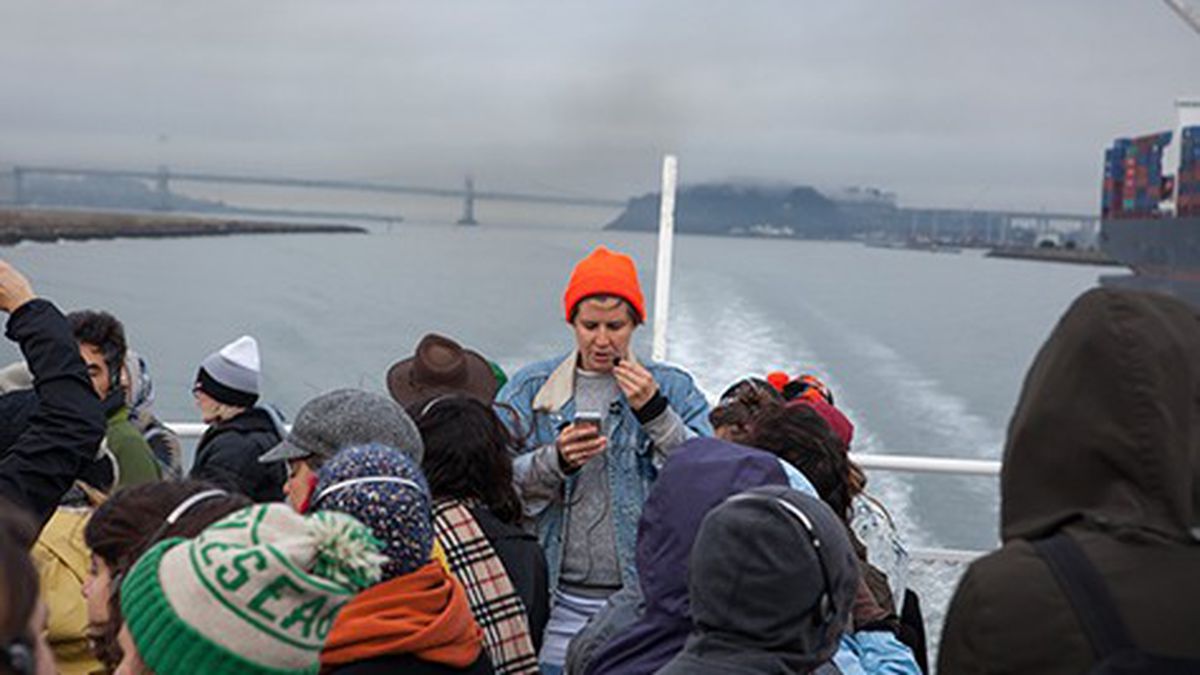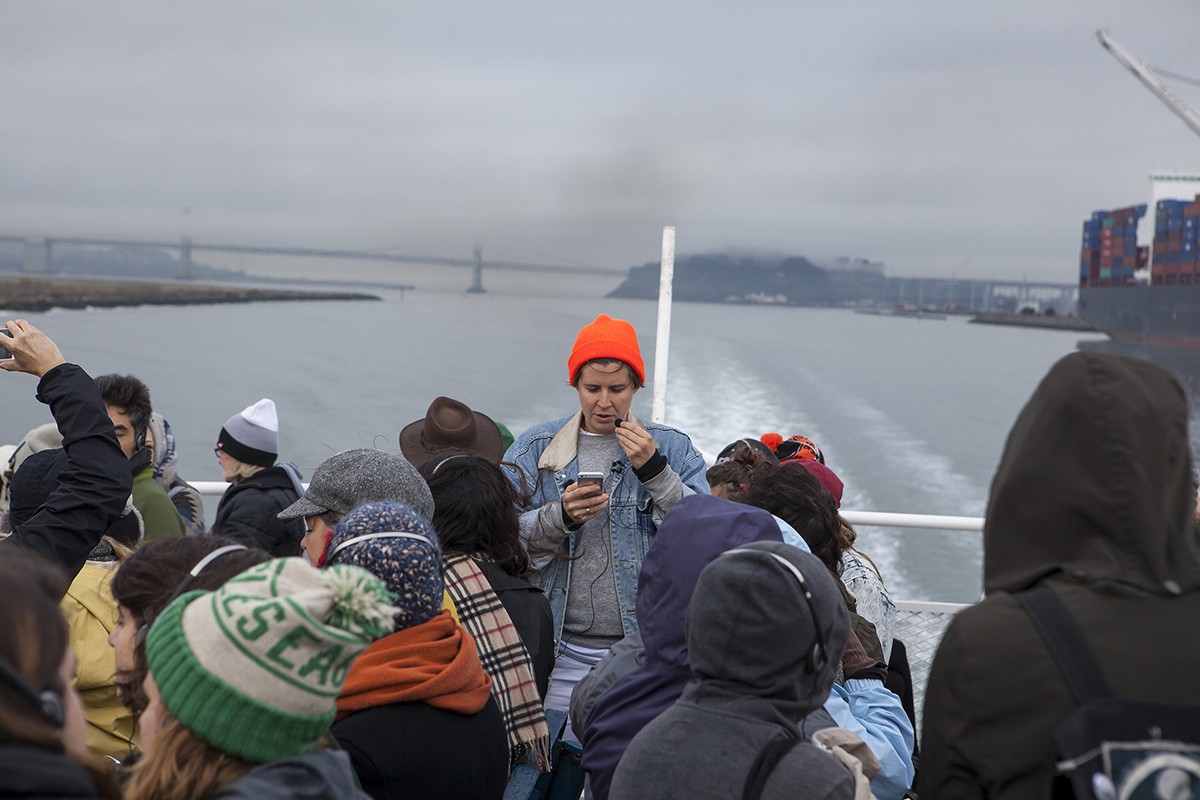On the first Sunday in December, I shuffled onto a public ferry scheduled to travel from San Francisco’s Embarcadero to Oakland’s Jack London Square with a group of fifty others, each of us wearing radio headsets, like conspirators on a covert mission. It was an especially chilly afternoon and the wind was moist in a numbing way. We were likely the only non-tourist passengers on the boat and surely would not have been there if it weren’t for Constance Hockaday.
We were on hand to experience You Make a Better Wall Than a Window, an audio tour performance piece by Hockaday that she broadcasted live from the front of the boat’s upper deck to be delivered in real time to our headsets. Hockaday’s earnest intonation streamed intimately into our ears as we burrowed inside our jackets to shield from the wilderness we were confronting — all of a sudden at sea. “It is a real testament of trust in the human race that you came on this ferry today,” Hockaday began. “…There are two goals of this tour, one is to get free and the other is to get real.”
Hockaday is the Bay Area’s foremost nautical artist. In 2011, she turned old boat hulls into floating hotel rooms in a marina on the outskirts of New York City for a project called Boatel done in collaboration with the Flux Factory. Reservations for the entire summer sold out in an hour, and Hockaday was swarmed by international media members for her DIY endeavor aimed, simply, to bring people closer to the water. Last summer, for a piece called All These Darlings and Now Us, she connected four sailboats to form a peep show venue in the San Francisco Bay. During the night, six hundred people were transported to the venue on inflatable rafts to watch performers who formerly strutted at The Lusty Lady and Esta Noche — the former the nation’s only worker-owned strip club, and the latter a historic Latino gay bar, both of which had sadly shut that year. “The idea, for me, was if there’s not space for this stuff on the land, then let’s make a space on the water,” said Hockaday on a recent afternoon in her West Oakland home.
A metaphorical and literal correlation between possibility and being in bodies of water is the conceptual thread that ties Hockaday’s projects together. For You Make a Better Wall Than a Window, it manifested as a kind of research-based poetry reading rather than a spectacle. As we passed underneath the Bay Bridge, Hockaday captained an informational voyage, reconceptualizing the water as “fast moving land” that, considering the flexibility of maritime law, can function as a loophole in the way society organizes space and the way capitalism and convention determine the limitations of our lives. “No one can own the water,” she said. The simple reminder was dramatically emphasized by the overwhelming vastness of the bay.
Hockaday grew up near the ocean in South Texas with a marine biologist father. At nineteen, she had dropped out of college after coming out as queer and growing deeply depressed. Living at home again, she was working on the beach, renting umbrellas. “I remember thinking, ‘I hate all the options that exist in the world for me,'” she said. One fateful afternoon, she happened upon four handmade rafts, each one home to four shacks and sprouting massive, scavenged sails. It was the Floating Neutrinos, a legendary group of transient intellectuals who live on the water to allow themselves the type of freedom that paying rent tends to inhibit and who consider raft-building a psycho-spiritual practice. “It blew my mind,” said Hockaday. “This sort of vagabond shack building reality just didn’t exist where I grew up.”
Naturally, Hockaday went aboard. The Neutrinos taught her skills that empowered her — from sign painting (a flexible source of income) to a method for realizing that as long as she understood what she wanted to do with her life, she had the capacity to follow those desires. “That is a really fucking hard thing to learn when nobody has ever suggested that to you before,” she said.
Hockaday then embarked on a series of vision quests, a lone backpacking trip across Europe, three college degrees, and a personal raft-building project that took her up and down the Multnomah Channel in Portland, Oregon. And as she evolved into an artist, a few events most propelled her philosophical shaping. First, a research project taught her about Nancy Boggs, a woman who, in the 1870s, floated an eighty-foot crimson brothel on the Columbia River between the jurisdictions of the two towns on either bank (an obvious inspiration for All These Darlings and Now Us). And in 2006, she helped build rafts for the street artist Swoon and her “punk artist” gang to sail down the Mississippi River as a performance art piece. She ultimately joined the crew, offering little kids along the way the same mind-boggling realization she had experienced at nineteen. Two years later, she captained one of the rafts in Swoon’s similar Swimming Cities of Serenissima project, which famously crashed the Venice Biennale with anarchic-troubadour style.
But Hockaday’s most recent performance, done in collaboration with Southern Exposure as part of the programming for Public Works: Artists’ Interventions 1970–Now, was more sobering than her past work. She highlighted the potential for oceanic freedom to support neoliberal business ventures and dwelled on the lack of land access to San Francisco Bay despite it technically being public space. As the ferry stalled next to the massive shipping cranes lining the Port of Oakland, the artist gestured toward the East Bay beasts: “White, brave beautiful fingers of globalization,” she said. “These are our arms and hands, the ones we use when we really want to make something happen in the world economic system.” Hockaday explained that the port is a trustee of tidelands, meaning that the public agency plays a leading role in deciding how the bay’s tidelands are used and to what extent they are made accessible to the public.
Lamenting the way that industry unfairly reigns over the shores of the East Bay, Hockaday urged attendees to fight for their right to the water. She framed it in terms of preservation, in terms of political justice and rightful ownership, and also in terms of psychology. Having access to the water affords us a sense of freedom and potential that’s crucial for realizing one’s own agency. She declared over the mic: “The infrastructure of our civilization defines our most private beliefs about what’s possible in our lives.”














